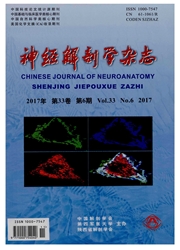

 中文摘要:
中文摘要:
为探讨cAMP反应元件结合蛋白(CREB)在小鼠脑低氧预适应形成过程中的作用,本研究应用Western blot技术结合Gel Doc凝胶成像系统,半定量检测了整体低氧预适应模型小鼠脑组织内CREB的磷酸化水平和非磷酸化水平的表达水平.结果显示:(1)随低氧暴露次数(H1-H4)的增加,小鼠海马组织内CREB的磷酸化水平(激活程度)明显增高(P<0.05;n=7);同样,大脑皮层内CREB的磷酸化水平也随低氧暴露次数(H1-H4)的增加而明显增高(P<0.05,n=7);(2)随低氧暴露次数(H1-H4)的增加,CREB的蛋白表达量无论在小鼠海马组织还是皮层组织内均无明显变化.以上结果提示CREB磷酸化水平的增高(激活)可能参与了脑低氧预适应的形成过程.
 英文摘要:
英文摘要:
To explore the role of cAMP response element binding protein (CREB) in the development of cerebral hypoxic preconditioning, Western blot and Gel Doc imaging system were applied to semi-quantitatively analyze the effect of repetitive hypoxic exposure (H1-H4) on the levels of CREB phosphorylation and protein expression in the brain of mice. The results showed that: (1) The levels of CREB phosphorylation were enhanced in response to the repetitive hypoxic exposure (H1-H4) both in the hippocampus and the cortex of mice. The statistic significance could be found at H1-H4 groups for both the hippocampus and the cortex (P 〈 0.05, n = 7 ) ; (2) No any significant changes could be found in the level of CREB protein expression both in the hippocampus and the cortex of mice. The preseat results suggest that the activation of CREB might be involved in the development of cerebral hypoxic preconditioning.
 同期刊论文项目
同期刊论文项目
 同项目期刊论文
同项目期刊论文
 期刊信息
期刊信息
